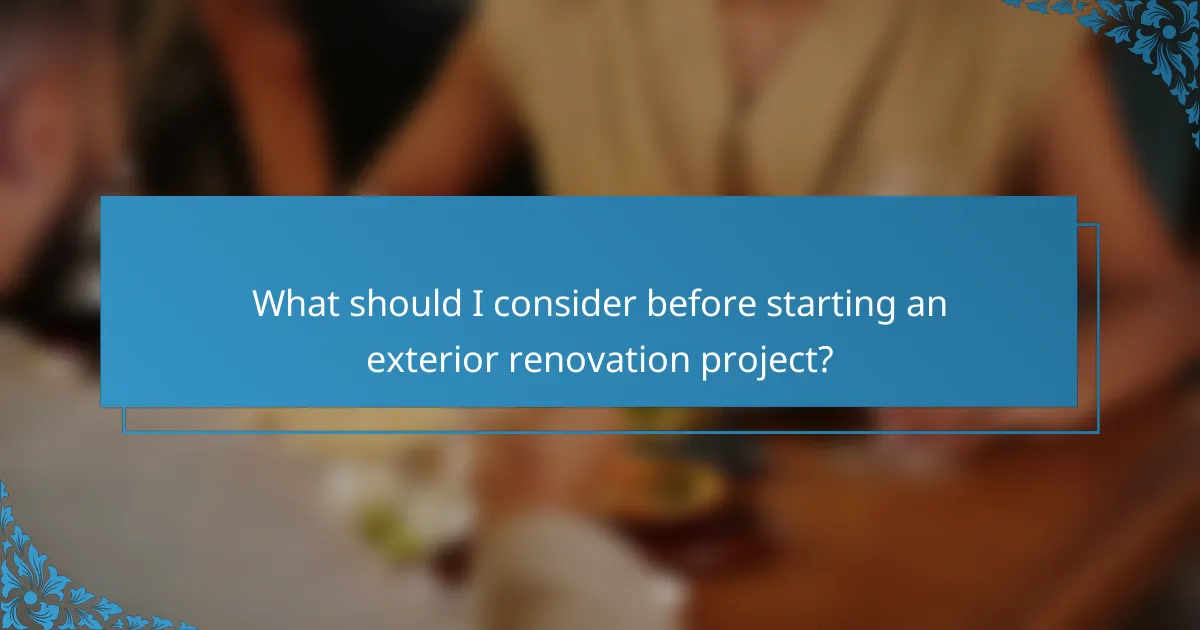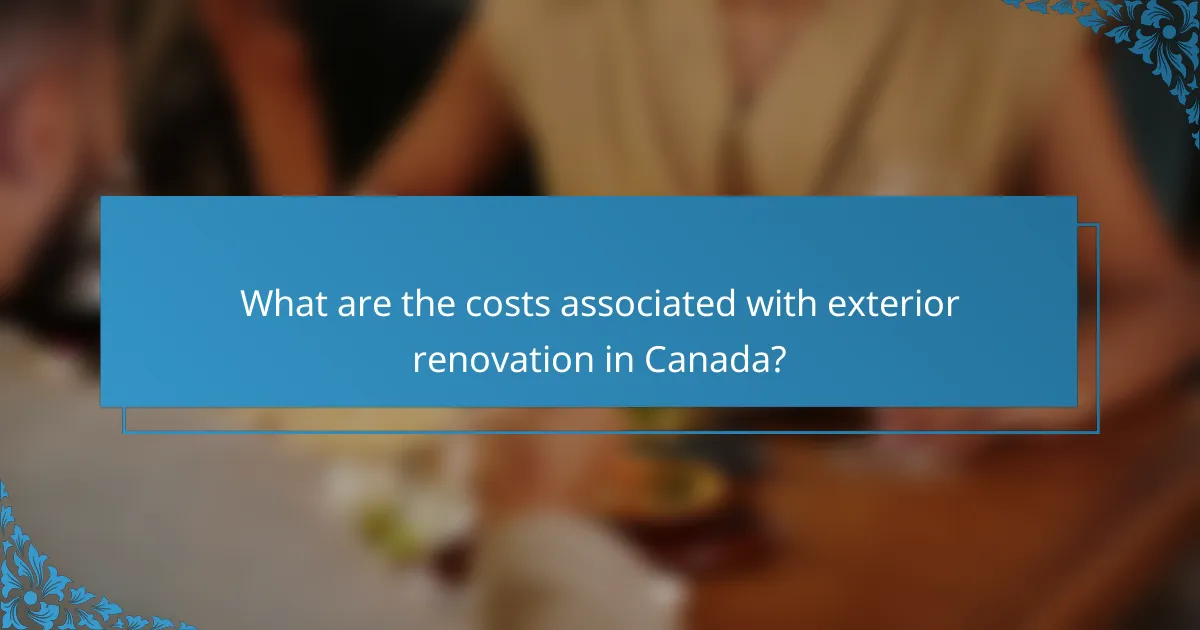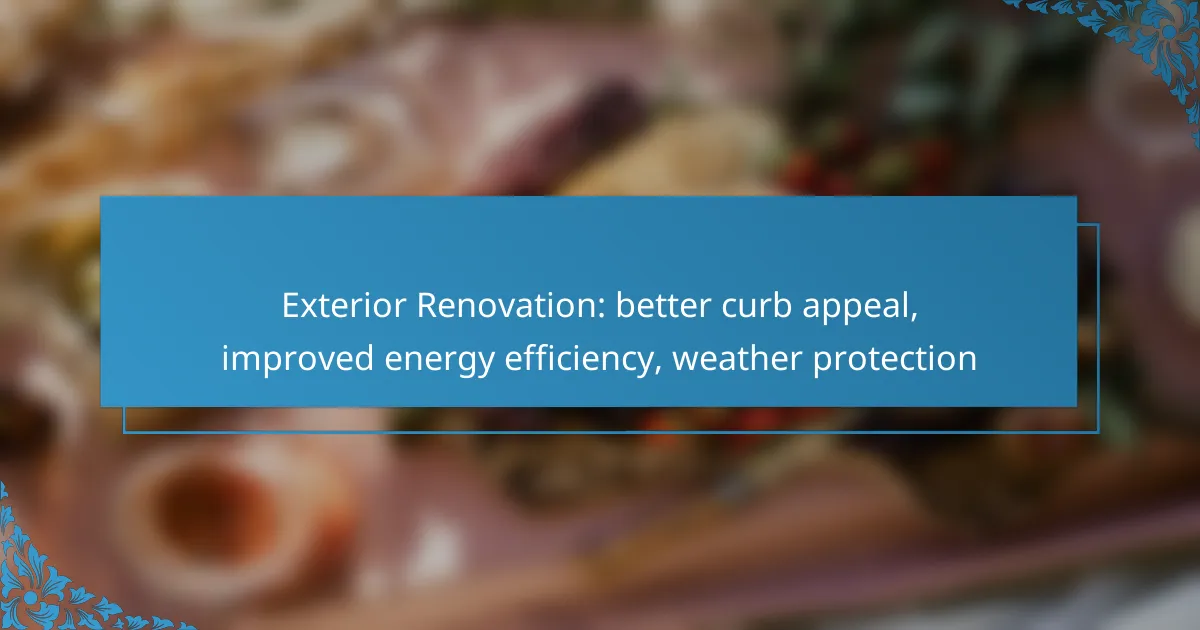Exterior renovation is a powerful way to boost your home’s curb appeal, making it more visually appealing and potentially increasing its market value. By focusing on energy efficiency and weather protection, these upgrades not only enhance the aesthetics but also improve insulation, reduce energy costs, and fortify the home against harsh elements.

How can exterior renovation improve curb appeal in Toronto?
Exterior renovation can significantly enhance curb appeal in Toronto by updating the visual aesthetics and functionality of a home. This not only makes the property more attractive but can also increase its market value and energy efficiency.
New siding options
Choosing modern siding materials can dramatically transform the look of a home. Options such as vinyl, fiber cement, or wood can offer different styles and durability levels, allowing homeowners to select based on their budget and desired appearance.
Consider the climate in Toronto when selecting siding; materials that withstand moisture and temperature fluctuations are ideal. Installation costs can vary, typically ranging from CAD 5 to CAD 15 per square foot, depending on the material.
Landscaping enhancements
Improving landscaping is a straightforward way to boost curb appeal. Simple changes like adding flower beds, shrubs, or decorative stones can create a welcoming atmosphere. Maintaining a tidy lawn and pruning existing plants also contributes to a polished look.
In Toronto, consider native plants that thrive in the local climate, requiring less water and maintenance. A well-planned landscape can increase property value by up to 20% in some cases.
Fresh paint colors
Applying a fresh coat of paint to the exterior can refresh a home’s appearance and protect it from the elements. Choosing colors that complement the neighborhood and reflect personal style is crucial for maximizing curb appeal.
In Toronto, neutral tones often work well, but bold accents can add character. Ensure to use high-quality, weather-resistant paint to withstand the local climate, with costs typically ranging from CAD 30 to CAD 70 per gallon.
Upgraded entryways
Enhancing entryways can create a strong first impression. Consider replacing old doors with modern designs, adding decorative trim, or installing a new porch that invites visitors in.
In Toronto, front doors made of fiberglass or steel offer durability and energy efficiency. Upgrading entryways can cost anywhere from CAD 1,000 to CAD 5,000, depending on materials and complexity.
Exterior lighting installations
Installing exterior lighting can improve safety and highlight architectural features. Pathway lights, porch lights, and accent lighting can create an inviting atmosphere while enhancing visibility at night.
In Toronto, energy-efficient LED lights are a popular choice, offering long-lasting illumination with lower energy costs. Budget for lighting installations to range from CAD 100 to CAD 1,000, depending on the scale and type of fixtures selected.

What are the energy efficiency benefits of exterior renovation?
Exterior renovation can significantly enhance energy efficiency by improving insulation, replacing windows, and addressing air leaks. These upgrades not only lower energy bills but also contribute to a more comfortable living environment.
Insulation upgrades
Upgrading insulation is one of the most effective ways to boost energy efficiency. Proper insulation minimizes heat transfer, keeping homes warmer in winter and cooler in summer. Consider materials like spray foam or fiberglass batts, which can reduce energy costs by up to 20-30%.
When choosing insulation, ensure it meets local building codes and has a suitable R-value for your climate. In colder regions, higher R-values are necessary to maintain comfort and efficiency.
Energy-efficient windows
Replacing old windows with energy-efficient models can drastically improve a home’s thermal performance. Look for double or triple-pane windows with low-emissivity (Low-E) coatings, which reflect heat while allowing light in. This can lead to energy savings of around 10-15% on heating and cooling costs.
Consider the window frame materials as well; vinyl and fiberglass typically offer better insulation than aluminum. Ensure proper installation to avoid air leaks that can undermine the benefits of new windows.
Cool roofing materials
Cool roofing materials can help lower roof temperatures, reducing the need for air conditioning during hot months. These materials reflect more sunlight and absorb less heat, which can decrease indoor temperatures by several degrees. This can lead to energy savings of 10-15% in cooling costs.
When selecting roofing materials, consider options like reflective shingles or tiles that meet ENERGY STAR standards. Local climate and building regulations may also influence your choice of roofing materials.
Sealing air leaks
Sealing air leaks is crucial for maximizing energy efficiency. Common areas for leaks include windows, doors, and attic hatches. Using caulk or weatherstripping can help close these gaps, preventing conditioned air from escaping and unconditioned air from entering.
Conduct a blower door test to identify leaks in your home. Addressing these leaks can improve energy efficiency by 5-15%, making it a cost-effective renovation step.

How does exterior renovation provide weather protection?
Exterior renovation enhances weather protection by reinforcing the building’s defense against elements like rain, wind, and temperature fluctuations. This is achieved through the use of durable materials, effective waterproofing techniques, and storm-resistant features that collectively improve the structure’s resilience.
Durable materials
Choosing durable materials is crucial for effective weather protection. Options such as fiber-cement siding, metal roofing, and high-quality vinyl windows can withstand harsh weather conditions better than traditional materials. These materials not only resist decay and damage but also require less maintenance over time.
When selecting materials, consider local climate factors. For instance, in areas prone to heavy snowfall, materials that can bear significant weight are essential. Investing in high-performance options can lead to long-term savings by reducing repair costs.
Waterproofing techniques
Waterproofing techniques are essential for preventing moisture infiltration, which can lead to mold and structural damage. Effective methods include applying waterproof membranes, sealants, and coatings to vulnerable areas such as roofs, basements, and around windows. These barriers help keep water out while allowing trapped moisture to escape.
Regular inspections and maintenance of waterproofing systems are necessary to ensure their effectiveness. Homeowners should check for signs of wear or damage, especially after severe weather events, and address any issues promptly to maintain the integrity of the structure.
Storm-resistant features
Incorporating storm-resistant features can significantly enhance a building’s ability to withstand extreme weather events. Features such as impact-resistant windows, reinforced doors, and storm shutters provide additional protection against high winds and flying debris. These elements are particularly important in hurricane-prone regions.
Homeowners should also consider landscaping choices that minimize wind exposure and reduce the risk of falling branches. Additionally, securing outdoor items can prevent them from becoming projectiles during storms, further safeguarding the property.

What should I consider before starting an exterior renovation project?
Before starting an exterior renovation project, it’s essential to evaluate your goals, budget, and local regulations. Understanding these factors will help ensure a successful renovation that enhances curb appeal, energy efficiency, and weather protection.
Budget planning
Effective budget planning is crucial for any renovation project. Start by determining how much you’re willing to spend, then allocate funds for materials, labor, and unexpected expenses, which can often arise. A good rule of thumb is to set aside around 10-20% of your total budget for contingencies.
Consider getting multiple quotes from suppliers and contractors to compare costs. This will help you identify the best value without compromising quality. Prioritize your renovation needs, focusing on areas that will provide the most significant return on investment.
Permits and regulations in Ontario
In Ontario, many exterior renovations require permits to ensure compliance with local building codes and zoning laws. Check with your municipality to determine which projects need permits, as this can vary widely depending on the scope of your renovation.
Common renovations that typically require permits include adding decks, fences, or significant structural changes. Failing to obtain the necessary permits can lead to fines and may require you to undo completed work, so it’s essential to stay informed about local regulations.
Choosing a reliable contractor
Selecting a reliable contractor is vital for the success of your renovation. Start by researching local contractors with good reviews and a proven track record in exterior renovations. Ask for references and check their previous work to ensure they meet your standards.
Once you’ve narrowed down your options, obtain detailed written estimates from at least three contractors. This will help you compare pricing and services. Ensure that the contractor is licensed and insured, as this protects you from potential liabilities during the renovation process.

What are the costs associated with exterior renovation in Canada?
The costs of exterior renovation in Canada can vary widely based on the scope of the project, materials used, and the region. Homeowners should expect to spend anywhere from several thousand to tens of thousands of Canadian dollars, depending on the specific upgrades and improvements desired.
Factors Influencing Costs
Several factors can influence the overall costs of exterior renovations. These include the size of the home, the complexity of the design, and the choice of materials. For example, using high-end siding or energy-efficient windows can significantly increase expenses compared to standard options.
Labor costs also play a crucial role, as they can vary by region and the expertise required for specific tasks. In urban areas, labor rates may be higher than in rural locations, impacting the total renovation budget.
Typical Cost Ranges
For exterior renovations, homeowners can expect typical cost ranges for various projects. Replacing siding can cost between CAD 10,000 and CAD 20,000, while window replacements might range from CAD 5,000 to CAD 15,000, depending on the number and type of windows.
Roofing projects can vary significantly, with costs generally falling between CAD 7,000 and CAD 15,000. It’s essential to obtain multiple quotes to compare prices and ensure a fair deal.
Budgeting Tips
When planning an exterior renovation, it’s crucial to set a realistic budget that includes both materials and labor. Start by prioritizing necessary repairs and improvements, and allocate funds accordingly. Consider setting aside an additional 10-20% of your budget for unexpected expenses that may arise during the project.
Research local contractors and read reviews to find reputable professionals who can provide accurate estimates. Don’t hesitate to negotiate and ask for detailed breakdowns of costs to ensure transparency in pricing.
